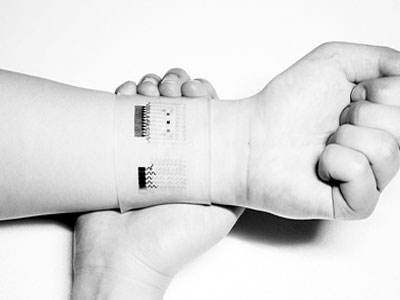[China Instrument Network Instrument R&D] With the popularity of smart terminals, wearable electronic devices represent a huge market prospect. As one of the core components, sensors will influence the functional design and future development of wearable devices. The flexible wearable electronic sensor is characterized by its thinness and portability, excellent electrical performance, and high integration, making it one of the most popular electrical sensors.
(Image from the Internet, invaded)
Sensors play a vital role in human health monitoring. In recent years, people have made remarkable progress in the field of wearable implantable sensors, such as the use of electronic skin to deliver skin tactile information to the brain, the use of three-dimensional microelectrodes to achieve control of the prosthetic cerebral cortex, the use of cochlear implants to restore patient hearing. However, achieving high resolution, high sensitivity, fast response, low cost manufacturing, and complex signal detection of flexible wearable electronic sensors remains a great challenge.
Researchers at the U.S. Air Force Research Laboratory and the Wise Institute of Biological Engineering at Harvard University have developed a flexibly scalable intelligence, surveillance, and reconnaissance sensor that has successfully overcome the bulky disadvantages of traditional ISR sensors and has greatly expanded the application of sensors.
The researchers prepared a flexible sensor for intelligence, surveillance, and reconnaissance by digitally printing the electronic components of the sensor onto a flexible, stretchable thin-film elastic material sheet.
The sensor has the same size as a band-aid and its weight is significantly reduced. This flexible sensor can be used in aircraft airbag systems to reduce aircraft maintenance costs and shorten maintenance cycles. In addition, the wearable sensor can also sense motion, predict and improve human body function.
Successful development of a flexible sensor with a band-aid size can significantly reduce the load on next-generation ISR sensors.
(Original Title: U.S. Air Force Scientists Successfully Developed Small-sized Flexible Sensors)
Inflatable Tent
The inflatable tent is produced by a combination of adhesive bonding and high-frequency thermal bonding.
The air columns are made of PVC double-sided coated fabric and the canopy is made of waterproof and
UV-resistant material, which has the advantages of fast forming, high strength, flame resistance, mold
resistance, UV resistance, and moisture resistance. The tent is an inflatable tent with an air column frame,
which is lighter, smaller, and easier to carry than a metal stand tent.
Set Up
The inflatable tent is relatively easy to set up, just lay the tent flat on an open space, connect it to a
foot pump or an electric pump and it can be set up in a few minutes by just two people.
Dismantling
The same applies to the dismantling of the tent. The dismantling and packing of the metal stand requires
a large number of people and takes a long time. The inflatable tent can be dismantled by simply letting
it deflate naturally or by pumping it up with an electric blower.
The advantages
The inflatable tent has incomparable advantages over ordinary metal tents, being lighter and smaller in
size and having advantages in transport that ordinary metal tents do not have. It is easy to erect and
dismantle and does not waste any more manpower or time, making it particularly suitable for rapid
response to emergencies. The inflatable tent can also be air-dropped when the environment is
too harsh to reach.
inflatable camping tent,inflatable tents,inflatable party tent,inflatable house tent,outdoor inflatable tent
Ningbo Autrends International Trade Co., Ltd. , https://www.outerlead.com
